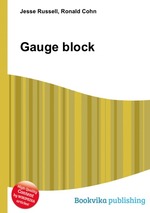Gauge block
Jesse Russell Ronald Cohn
бумажная книга
High Quality Content by WIKIPEDIA articles! A gauge block (also known as a gage block, Johansson gauge, slip gauge, or Jo block) is a precision ground and lapped length block used as a measuring standard. Invented in 1896 by Swedish machinist Carl Edvard Johansson, they are used as a reference for the calibration of measuring equipment used in machine shops, such as micrometers, sine bars, calipers, and dial indicators (when used in an inspection role). Gauge blocks come in sets of blocks of standard lengths. In use, the blocks are stacked end-to-end to make up the desired length. Gauge blocks are the main means of length standardization used by industry.


